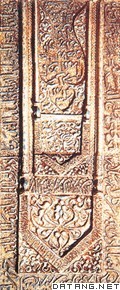1) traditional calligraphy


传统书法
1.
Some masterpieces have made good use of traditional calligraphy to promote their quality.


传统书法具有结构美、意象美以及表现形式丰富等优点,在标志、招贴、包装、书籍等设计领域可以充分利用这一宝贵的艺术形式。
2.
In order to guide people to apprehend and to apply the traditional calligraphy correctly to the process of copying and producing calligraphy, this issue made a clear analysis and research on the "traditional calligraphy".
通过对不同名词加以分析、解释,使我们清醒地认识到应该掌握什么样的、哪一时间段的书法传统,本文认为应在成熟的传统书法(经典作品)中去体现,如魏晋时期。
2) Calligraphy tradition


书法传统
1.
Calligraphy tradition is composed of three hierarchies: "skills","techniques" and "Tao".


书法传统是一个由“技”、“法”与“道”三个层次构成的,以艺术家的内在情感体验、审美与情感抒发为内在动力,书法艺术社会价值与经济价值为外在驱动力的不断流失与替补的动态螺旋状发展系统。
2.
Taking the performance process from physical skills (that is the brush-pen holding and the brush-pen running) to Tao (yin and yang, which refers to calligraphy tradition or spirit of calligraphy) as a start, the author expatiate a Chinese calligraphy traditional arguments that ingenious skills can be Tao.
本文通过对“书法传统”作清晰地分析、研究和梳理,以指导我们在书法临摹与创作过程中正确地理解和运用书法传统。
3) cultural tradition of calligraphy


书法文化传统
4) Chinese traditional calligraphy


中国传统书法
1.
The researcher discusses the feasibility and the value of introducing the western aesthetic psychological theories into the aesthetic research of Chinese traditional calligraphy.
研究者探讨了对中国传统书法审美研究的过程中,引进西方审美心理学理论的意义和可行性问题,认为应该以中国传统书法理论为根本,与西方理论进行对接。
5) traditional calligraphy elements


传统书法元素
1.
The paper falls into four parts: The first part,traditional calligraphy elements and modern graphic design.
中国传统书法元素在世界艺术中是具有特色的,在设计领域空前国际化的语境中,有特色的传统文化元素就显得弥足珍贵,把传统书法元素运用在当代平面设计中,有着广阔的前景和审美价值。
6) traditional books


传统图书
1.
Based on a comparison of digital books with traditional books,this paper concludes that the appearance of the former has great revolutionary and progressive significance,and has superiorities over the latter in many respects.
通过对数字图书与传统图书进行比较来阐述数字图书是一种革命和进步,具有很多方面的优势。
补充资料:阿拉伯书法
| 阿拉伯书法 Arabian calligraphy 伊斯兰时代的阿拉伯文字书写艺术。起源于手抄本的《古兰经》。阿拉伯书法具有悠久的历史,而且字体繁多。一般认为,11世纪是划分阿拉伯书法时期的界线,之前为古体时期,之后为新体时期。古体时期的阿拉伯书法以库菲体出现最早,其书法笔画纵向,线条直而棱角分明,有一定装饰味。9~10世纪又一分为二,出现了叶状库菲体和花状库菲体,皆因笔画末端似棕叶状和饰有花头纹而得名。另外,还有一种繁琐而规范的手写体及印刷体,以结体工整圆润,笔画舒展流畅为其特征,有纳斯黑体和斯尔希体等不同字体。11世纪之后,在古体书法继续流行的同时,又相继出现了4种新的字体,即:①穆哈卡克体,风格清秀,笔画纤瘦;②拉伊哈尼体,风格活泼奔放,笔画末端呈鼠尾状;③鲁库阿体,用于书信的书写及手抄本通俗读物;④塔乌奇体,风格庄重大方。另外,还有一些字体流行,如:马格里比体,以活泼潇洒,节奏分明著称;纳斯塔里克体,笔画更加纤细流畅;希卡斯塔体,笔画比较繁琐;加里体,用于公文书写,以及专门用于苏丹签名,形如装饰绘画的图画文字的花字体。阿拉伯书法非常重视文字本身的形式美,因此其书法讲究节奏感、装饰性和纹样。由于是用硬笔在羊皮纸上自右而左横向书写,所以笔画简洁流畅,具有一种曲线的效果。
|
说明:补充资料仅用于学习参考,请勿用于其它任何用途。
参考词条
